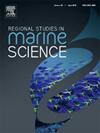追踪苏安斯河口(西班牙北部)的污染遗产:矿井关闭后测年方法和生态恢复的挑战
IF 2.4
4区 环境科学与生态学
Q3 ECOLOGY
引用次数: 0
摘要
河口是全球受到威胁的生态系统,需要紧急评估其历史恶化和恢复过程,为可持续管理的现实战略提供信息。本研究采用综合的多学科方法,包括分析地表样品和短(47 cm)沉积物岩心中的痕量金属、有孔虫和放射性核素,以评估严重污染的Suances河口(西班牙北部)的环境演变及其对2003年欧洲最大的碳酸盐岩铅锌矿之一Reocín含金属矿床的历史采矿活动的响应。岩心样品中Zn(最大值>;10,000 mg kg−1)、Pb(最大值;2700 mg kg−1),Cd(35.3 mg kg−1)和Hg(41 mg kg−1),超过当地背景值,经常超过沉积物质量指南。尽管表面样品的金属浓度总体上在2003年(最大年)之间有所下降。Zn值:11,200 mg kg−1;铅:2200 毫克公斤−1;Cd: 26.4 mg kg−1)和2022(最大)。Zn值:8520 mg kg−1;铅:990 毫克公斤−1;Cd: 20.5 mg kg−1),显著的空间变化表明泥沙在河口内重新分布。此外,有孔虫的丰度仍然极低(直立作物范围:1-510个体/ 80 cm3),表明持续不利的环境条件对生命和繁殖。沉积记录中异常的210Pbxs信号揭示了与采矿活动开发和随后放弃相关的人为事件的影响。这些发现强调了历史污染河口系统中沉积物年代学和环境反应的复杂性,强调了在多学科框架内进行长期监测计划的必要性。本文章由计算机程序翻译,如有差异,请以英文原文为准。
Tracing pollution legacies in the Suances Estuary (N Spain): Challenges for dating methods and ecological recovery after mine closure
Estuaries are globally threatened ecosystems, requiring urgent assessment of their historical deterioration and recovery processes to inform realistic strategies for sustainable management. This study employs an integrated, multidisciplinary approach, including analyses of trace metals, foraminifera, and radionuclides in surface samples and short (47 cm) sediment cores, to evaluate the environmental evolution of the heavily polluted Suances Estuary (N Spain) and its response to the cessation in 2003 of historical mining activities of one of Europe’s largest carbonate-hosted Pb-Zn ores, the Reocín metalliferous deposits. Core samples showed elevated concentrations of Zn (maximum value >10,000 mg kg−1), Pb (max. 2700 mg kg−1), Cd (35.3 mg kg−1), and Hg (41 mg kg−1), exceeding local background values and often surpassing Sediment Quality Guidelines. Despite an overall decrease in metal concentrations from surface samples between 2003 (max. value of Zn: 11,200 mg kg−1; Pb: 2200 mg kg−1; Cd: 26.4 mg kg−1) and 2022 (max. value of Zn: 8520 mg kg−1; Pb: 990 mg kg−1; Cd: 20.5 mg kg−1), significant spatial variations suggest sediment redistribution within the estuary. Moreover, foraminiferal abundances remain extremely low (range of standing crops: 1–510 individuals per 80 cm3), indicating persistent unfavorable environmental conditions for life and reproduction. Abnormal 210Pbxs signals in the sedimentary record unveil the impact of anthropogenic events related to the development and subsequent abandonment of mining activities. These findings underscore the complexity of sediment chronologies and environmental responses in historically contaminated estuarine systems, highlighting the need for long-term monitoring programs within a multidisciplinary framework.
求助全文
通过发布文献求助,成功后即可免费获取论文全文。
去求助
来源期刊

Regional Studies in Marine Science
Agricultural and Biological Sciences-Ecology, Evolution, Behavior and Systematics
CiteScore
3.90
自引率
4.80%
发文量
336
审稿时长
69 days
期刊介绍:
REGIONAL STUDIES IN MARINE SCIENCE will publish scientifically sound papers on regional aspects of maritime and marine resources in estuaries, coastal zones, continental shelf, the seas and oceans.
 求助内容:
求助内容: 应助结果提醒方式:
应助结果提醒方式:


